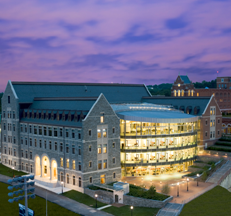As this new decade begins, a prominent overtone that is in the spotlight of the bright minds of modern architects is sustainable design. The enthusiasm for environmental consideration when designing new buildings is centered in the most vibrant cultural centers: our universities, where some of the worlds’ most vitalizing minds work in tandem to create sustainable designs for future generations’ prosperity and use as well as their own.
The LEED system, developed in 2000 by the U.S. Green Building Council, stands for Leadership in Energy and Environmental Design. This LEED system was created to assess a new structure based on criteria such as water and energy efficiency, waste reduction, and promotion of physical activity.

(image courtesy of The Hariri Foundation)
Upon the opening of the most recent addition to their campus in 2009, the Rafik B. Hariri Building, which now houses the entire McDonough School of Business, represents the first Georgetown University facility that has become eligible for such a LEED certification, characterizing the building as one of the pioneers of sustainable architecture.
The idea behind sustainable architecture centers on the pursuit of the minimal environmental footprint. The less left behind to pollute the commons (the earth, air, and water), the smaller the imprint upon the ecosystem and its inhabitants.
As in all systems, the ideal is centered upon 100% efficiency. However, according to the second law of thermodynamics, a completely non-entropic system is impossible. There will always be a waste product, no matter how small. The main goal of green architects is not only reduce the necessary energy requirements of any building, but also to improve the ability of the structure to generate its own electricity and energy.
 (image courtesy of Georgetown Alumni)
(image courtesy of Georgetown Alumni)
“We were pretty far into the design process for the building when we suddenly realized we could do more to be environmentally responsible. That’s when we began making deliberate decisions that led us towards applying for LEED certification,” said Karen Frank, panelist and vice president for university facilities and student housing at Georgetown.
Some of the components of a sustainable structure, and the Harik B. Hariri Building, can and do include priority parking for hybrid and energy-efficient vehicles, conveniently located bike racks at every entrance and exit, larger interior and exterior courtyards to promote increased physical activity, and installing automatic heating, air-conditioning, and lighting to power down when not in use.

As a frontrunner in the pursuit of reduced-impact facilities and structures, Georgetown not only sets an honorable example to other universities, but also encourages neighboring communities to explore green architecture and less-intrusive construction.
(image courtesy of Georgetown University)
This article is written by the staff at Biotechnology Calendar, Inc., a networking company connecting researchers with suppliers of laboratory equipment for over 18 years. Our Georgetown University BioResearch Product Faire™ was on June 16th, 2011. Visit and register for our the next BioResearch Product Faire™ tradeshow in the northeast to connect with the top researchers and to exhibit new laboratory products at Columbia University on October 18, 2011. Researchers, to learn about the latest lab equipment in their fields, are encouraged to attend. Click the button below for more information.


